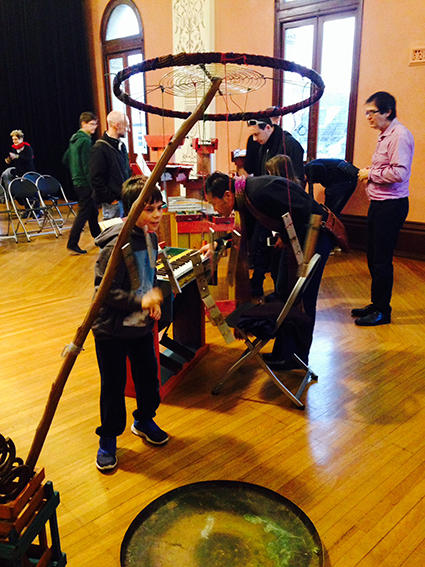Scientific conception, sonic sensation
Felicity Clark: Common Eclectic #6

Common Eclectic, Clocks and Clouds
photo Felicity Clark
Common Eclectic, Clocks and Clouds
In one of nine Common Eclectic concerts staged by independent music promoter Places and Spaces in the refurbished Glebe Town Hall, Clocks and Clouds (Kraig Grady and Terumi Narushima) explored the sonic combinations available when an historic and now sound-proofed ballroom, metal bars and a homemade foot-pedalled organ meet. The instruments appear deliberately positioned to maximise resonance and audience interplay, the performance not so much ‘a work’ or series of pieces as a collection of structured soundscapes. My sticky-beak at their scores before the show revealed some written conventionally, albeit in shorthand, and others looking like pictograms and alphabetical pentograms. The music is theirs alone, in a language they have devised to facilitate experimentation in, and reaction to, their environment.
Grady only composes for instruments he himself has built, exploring ancient sacred scales, pure harmonic tuning and multidimensional geometries. Clocks and Clouds introduce us to a tree made of dangling metal chimes, a microtonally-tuned vibraphone and a set of seven bass Meru Bars that look like a plumber’s sculpture garden and sound as a glockenspiel must to a hummingbird. The music emanating from whooming, echoing bars—hung by elastic above vertical freestanding PVC resonators—induces a dull aching, if pleasurable vibration behind the eyes. Together with Narushima’s retuned and redesigned Meta-slendro Harmonium—a small foot-fanned keyboard instrument washed in pink and yellow paint—they interweave driving rhythms similar to relentless Thai court music or wind-chimes in a cyclone. The effect is glimmering and ephemeral—each vibraphone sound decaying so quickly that for the interplay of dissonances and aural-adjustments to take place, the pair must change pitches and rearticulate often. Pure harmonics glisten and bounce.
Grady knows his instruments inside out and uses their idiosyncrasies, particularly their harmonic interplay, to advantage. What’s special about this music is that while it is clearly mathematically and scientifically conceived, behind these calculations is a quest for aesthetic beauties and new frontiers of sonic sensation—it’s about the concept of perception before the abstractions and material manipulations that afford such perceptions come into play. The ways vibrations might feel are more important that the means by which they are harnessed. So while Grady and Narushima’s music looks and sounds very technical, pattern-laden and designed, its form is subordinate to the sensations it elicits—cloudy crepuscular impressions.
Though lyrical, Clocks and Clouds’ music had no words; Grady prefers listeners to infer what they will. Vocalist Karen Cummings of the duo A Body of Water says, “I look at the words first when I think about music, and am really interested in the intersection between ideas, music and politics. I want to perform music that speaks strongly to the world now.” She and Stephen Adams explored songs in many styles. They shared their passion for the intimacy and fragility of a song recital, “imagined as an exploration of the inner life through words, vocal resonance and breath” (program note). A Body of Water performed original compositions and re-workings of familiar tunes in unfamiliar guises. While Adams tinkered with mandolin, flute, piano, field recordings and electronic gadgets, Cummings’ soprano soared, her cross-genre specialisation and song-choices playing to her vocal strengths. She is an expert in cabaret song and is currently researching the impact of amplification on the performance of vocal repertoire.
Common Eclectic#6: Clocks and Clouds, musicians Kraig Grady, Terumi Narushima; A Body of Water, performers Karen Cummings, Stephen Adams; Glebe Town Hall, Sydney, 21 June
RealTime issue #128 Aug-Sept 2015 pg. 49






